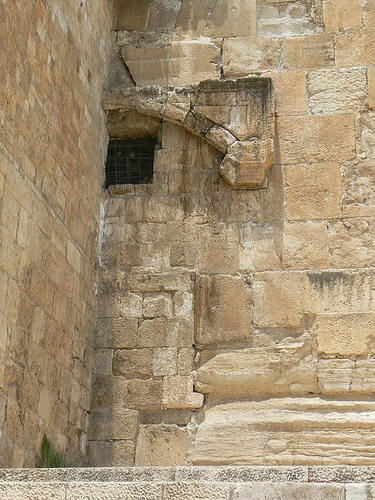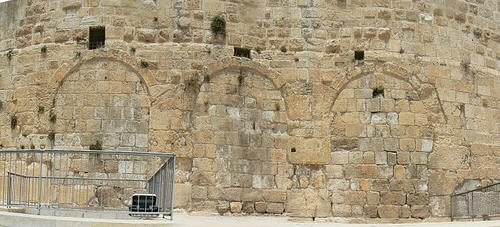.jpg)
.jpg)
.jpg)
.jpg)
.jpg)
.jpg)
.jpg)
.jpg)
.jpg)
.jpg)
.jpg)
.jpg)
.jpg)
.jpg)
.jpg)
.jpg)
Bus Ride and Hike to Temple Mount
.jpg)
.jpg)
.jpg)
.jpg)
.jpg)
.jpg)
.jpg)
.jpg)
.jpg)
.jpg)
.jpg)
.jpg)
.jpg)
.jpg)
.jpg)
.jpg)
Herod's Gate next two photos
unknown when constructed, located in the East of northern wall.
.jpg)
.jpg)
.jpg)
Lion's Gate entrance at top of hill
.jpg)
.jpg)
Golden Gate sometimes called the Eastern Gate
The Golden Gate, as it is called in Christian literature. Jews used to pray for mercy at the gate, hence the name Sha’ar Harachamim, the Gate of Mercy.
In Arabic, it is known as the Gate of Eternal Life. In ancient times, the gate was known as the Beautiful Gate. It was probably built in the 520s AD, as
part of Justinian I’s building program in Jerusalem, on top of the ruins of an earlier gate in the wall. An alternate theory holds that it was built in the
later part of the 7th century by Byzantine artisans employed by the Umayyad khalifs. The gate is located in the middle of the eastern side of the Temple
Mount. According to the Jewish tradition, this is the gate through which the Messiah will enter Jerusalem. Ottoman Sultan Suleiman I sealed off the
Golden Gate in 1541, allegedly to prevent the Messiah’s entrance.
.jpg)
.jpg)
.jpg)
Huldah Gates
The Huldah Gates are two sets of now-blocked gates in the south wall of the Temple Mount, which is also one of Jerusalem’s Old City walls. The western
set is a double arched gate (the double gate), Each arch of the double gate led into an aisle of a passageway leading from the gate into the Mount, and to
steps leading to the Mount’s surface. The double-arch gate on the western side of the south wall is mostly hidden by the medieval structure. Only the east
most side is seen. The western gate is overlooking the "Teaching Steps" where Jesus preached outside the Temple.

Close-up of western gate
and the eastern gate on the south wall is a triple arched gate (the triple gate). The Gates was constructed By Herod the Great as Gates to the Temple Mount,
only the base of the gate is originally from the second Temple.

Close-up of eastern gate above - seen on right side of next two big photos below
.jpg)
.jpg)
.jpg)
Dung Gate
Dung Gate (Sha’ar HaAshpot, Bab al-Maghariba, Gate of Silwan, Mograbi Gate) constructed – 1538-40, is situated near the southeast corner of the old
city, southwest of the Temple Mount. It was originally much smaller, but was enlarged in 1952, after the Old City came under Jordanian control in 1948.
The name Sha’ar Ha’ashpot appears in the Book of Jeremiah. It is probably named after the residue that was taken from the Jewish Temple into the
Valley of Hinnom, where it was burned. This ancient “Dung Gate” may not have been in the same location as the modern gate.
.jpg)
.jpg)
.jpg)
.jpg)
.jpg)
Western Wall
.jpg)
.jpg)
Notice that the Men and Women are sectioned apart by a petition at the Western Wall
Picture was taken between narrow spacing of two boards on a overhead walkway to to the Temple Mount
.jpg)
.jpg)
.jpg)
.jpg)
.jpg)
.jpg)
.jpg)
Temple Mount
Like many sites in Jerusalem, the Temple Mount is sacred to Jews, Muslims and Christians. Originally, it was the site of the great Temple of Jerusalem, the holiest place
in Judaism. For Muslims, it is the site of the Prophet Muhammad's journey to heaven described in the Qur'an. Finally, Christians revere it as a place frequently visited by
Jesus and some believe it will play a major role in end-time events.
According to the New Testament, the Temple of Jerusalem played a significant role in the life of Jesus. After his birth (around 4 BC), Jesus was dedicated at the Temple
in accordance with the Law of Moses (Luke 2:22-28). When he was a boy, he impressed the Jewish teachers with his knowledge (Luke 2:41-52). Jesus was later tempted
by Satan to jump off the Temple to prove his status (Matthew 4:1-11, Mark 1:12-13, and Luke 4:1-13) and he angrily overturned tables of moneychangers during the
"Cleansing of the Temple" (Matthew 21:12, Mark 11:15-19, Luke 19:45-48, John 2:14).
The location of the Temple has not been identified with certainty. Many scholars believe it stood on the present site of the Dome of the Rock, but others have proposed
locations at the north or south end of the platform. Today, the primary structures on and around the Temple Mount are these:
Al Aqsa Mosque (720 AD). One of the oldest and most beautiful mosques in the world, located next to the entrance to the Temple Mount.
Dome of the Rock (691 AD). A splendid edifice covered with blue mosaic tiles and a gold dome. It contains the rock from which Muhammad is believed
to have ascended into heaven on his Night Journey (Qur'an 17), which is also believed to be the site of Abraham's near-sacrifice of Isaac (Genesis 22).
Dome of the Chain (13th century in current form). A smaller dome of uncertain purpose, with beautiful decorations.
Western Wall - The retaining wall of Herod's Temple, this is the focus of an open-air synagogue and is the holiest Jewish site in the world.
Islamic Museum - focuses on Islamic architecture on the Temple Mount
Solomon's Stables - These underground chambers filled with pigeons are part of the substructure of the Temple Mount constructed by Herod.
.jpg)
.jpg)
.jpg)
.jpg)
.jpg)
.jpg)
.jpg)
.jpg)
Al Aqsa Mosque (720 AD). One of the oldest and most beautiful mosques in the world, located next to the entrance to the Temple Mount
.jpg)
.jpg)
.jpg)
.jpg)
.jpg)
.jpg)
.jpg)
.jpg)
.jpg)
.jpg)
.jpg)
.jpg)
.jpg)
.jpg)
.jpg)
.jpg)
.jpg)
.jpg)
.jpg)
.jpg)
.jpg)
.jpg)
.jpg)
.jpg)
.jpg)
.jpg)
.jpg)
.jpg)
.jpg)
.jpg)
Inside view of Golden Gate
.jpg)
.jpg)
.jpg)
.jpg)
.jpg)
.jpg)
.jpg)
.jpg)
Eye of the Needle
The 'eye of the needle' is another term for the 'needle gate'. The walled city of Jerusalem closed it's doors at night. The needle gate was used for anyone
coming in after dark. But it was a narrow and small passage. A person coming through would first have to take the entire load off the camel, walk it
through the needle gate numerous times, and then put the camel on it's knees and push from behind to squeeze it through the opening. This practice
ensured that the 'needle gate' could not be used for large scale military attacks at night.
.jpg)
.jpg)
.jpg)
.jpg)
.jpg)
.jpg)
.jpg)
.jpg)
Exiting through the Lion's Gate
.jpg)
.jpg)
.jpg)
Exiting Old City for Bus Ride to Mount of Olives
.jpg)
.jpg)
.jpg)
.jpg)
.jpg)
.jpg)
.jpg)
.jpg)
.jpg)
.jpg)
.jpg)
.jpg)
.jpg)
.jpg)
.jpg)
.jpg)
.jpg)
.jpg)
.jpg)
.jpg)
.jpg)
.jpg)
.jpg)
.jpg)
.jpg)
.jpg)
.jpg)
.jpg)
.jpg)
View of Kidron Valley between Old City Temple Mount and Mount of Olives
The Kidron Valley is the valley on the eastern side of The Old City of Jerusalem which features significantly in the Bible. An ephemeral stream flows
through it with occasional flash floods in the rainy winter months. The Kidron Valley runs along the eastern wall of The Old City of Jerusalem,
separating the Temple Mount from the Mount of Olives. It then continues east through the Judean Desert, towards the Dead Sea, descending 4000 feet
along its 20 mile course.
.jpg)
.jpg)
.jpg)
.jpg)
.jpg)
.jpg)